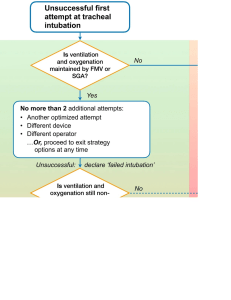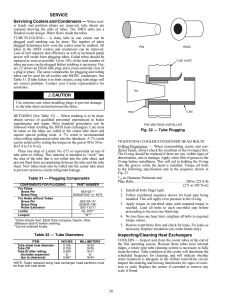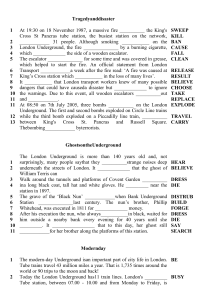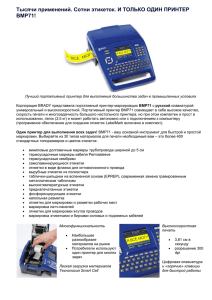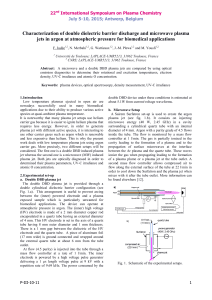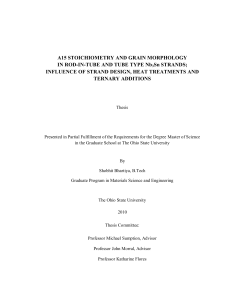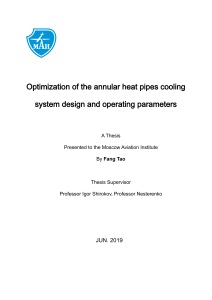Мониторинг давления в манжете эндотрахеальной трубки у
advertisement

1 . . , . 2 . 1 , . . 2 , . . , . . 1 . . . ; , 2 , Endotracheal Tube Cuff Pressure Monitoring in Children V. V. Lazarev1, E. M. Kopteva2, L. E. Tsypin1, I. G. Khamin2, D. V. Dorokhov 1 Department of Pediatric Anesthesiology and Intensive Care, N. I. Pirogov Russian National Research Medical University, Moscow, Russian Federation 2 Russian Children's Clinical Hospital, Ministry of Health and Social Development, Moscow, Russian Federation — . . . (22 ) 2- 16- , . (12 5- 18- , 3- ), «Pressure Easy», ( 1) — 8 . , ( . 36,4% 30 . . )—4 , 31,8% 31,8% , , . 20—30 20 . . . ., 1 . . . . , «PressureEasy» . : , , , , , , . Objective: to estimate tracheal morphological changes in children, by using a device for the continuous monitoring and regulation of endotracheal tube cuff pressure. Subjects and methods. Two groups of children were examined. In Group A comprising 22 children aged 2 months to 16 years, the adequacy of the external control balloon palpation method was estimated to measure endotracheal tube cuff pressure. In Group consisting of 12 children aged 5 to 18 years on mechanical ventilation for more than 3 days, the efficiency and appropriateness of applying a PressureEasy device for monitoring the pressure in the endotracheal tube cuff were assessed to prevent postintubation tracheal complications. In the latter group, the authors identified a study subgroup (BI) of 8 patients where this device was employed and a control group of 4 patients (BII) where it was not used. Results. Group A showed that endotracheal tube cuff pressure was 20—30 cm H20 in 31.8% of cases, greater than 30 cm H20 in 36.4%, and lower than 20 cm H20 in 31.8%. Subgroup BI displayed considerably lower macro- and microscopic histological changes than Subgroup BII. Conclusion. Determination of endotracheal tube cuff pressure by palpation of the external control balloon does not reflect its real values. The magnitude of tracheal changes is more intensive if continuous monitoring and regulation of pressure in the endotracheal tube cuff is absent. The PressureEasy device to monitor endotracheal tube cuff pressure permits its variability maintenance at a given level, by mitigating the damaging effect of the cuff on tracheal tissue. Key words: endotracheal tube, cuff, histology, ischemia, prevention, pressure, trachea. , [1—6]. . 1 19% [7]. — 14—80% [8—10]. , , . (Correspondence to): 100 20—50 - 4—12% [11—14]. , - E-mail: lazarev_vv@inbox.ru , 2012, VIII; 2 43 . . - «Portex™» (Smiths Medical Int., ). , , , [15—17]. , [18]. , — ( . . , 12- . ( ) 5- 183- , , - - «Pressure Easy» (Smiths Medical Int., ), - ). . ( )—4 «Pressure Easy» [19]. — 20—30 . ( 20—30 . [18, 20—22]. 8- ) . ., - , . . [23, 24]. , , . , - - . , 20 ( 1) — 8 . — , , - [25]. , . - , 1 ; ; «Portex™» 2 - , - , , . - [26]. , - , 2 . LF-GP, Olympus ( ( ), Servo-i, Maquet ( ). AVE A, Viasys 150 ( ). - ), Newport . , , . 3—5 3- , , . ( 7—10- ), . , , . . 10% 34 ( ) 2- . 16- . 22 , 2210 , — 20—30 . , 20 . 85 . 30 .( . ( . . . ., 8. . ). , ), 7- (31,8%) (36,4%) 7- (31,8%) - 44 , 2012, VIII; 2 . , , , , , . II 1— , 3- , , - , . . 3- ( ) , , . . II ( ) , 10- - . . , , . , . - I - , , «Pressure Easy» , - , 20—30 . ; . — . : II 11- . II . , . 30 . . 40 ( 17- 0,5 ) 2,5 . , — 12 20 . . ( . 3- ), , . . - 3- I . , II, 1; , — 3. , . 3, ( 7- — 10- . — ). . , — , 2012, VIII; 2 45 «Pressure Easy» , . , . . References 1. . ., . ., . . . 1. Likhvantsev V. V., Selivanov D. D., Fedorov S. A. et al. Specific features of mixed anesthesia with preserved spontaneous breathing in elderly patients. Obshchaya Reanimatologiya «(In Rus.)» 2011; VII (6): 46-52. 2. Moroz V. V., Likhvantsev V. V., Fedorov S. A. et al. General anesthesia with preserved spontaneous breathing through an intubation tube. Obshchaya Reanimatologiya «(In Rus.)» 2010; VI (4): 43-48. 3. Podkamenev V. V., Kovaleva I. A., Subbotina M. V. et al. Traumatic tracheal avulsion in a child: a case of successful treatment. Detskaya Khirurgiya «(In Rus.)» 2003; 4: 49-50. 4. Trunin E. M., Mikhailov A. P. Treatment for neck wounds and injuries. Saint Petersburg: ELBI-SPb.; 2004. . 2011; VII (6): 46—52. 2. . ., . ., . . . . 2010; VI (4): 43—48. 3. . ., . ., . . : . . 2003; 4: 49—50. 4. . - ., .; 2004. . . . .: 5. Vanner R. G. Cricoid pressure in chaos. Anaesthesia 1998; 53 (1): 94—95. 5. Vanner R. G. Cricoid pressure in chaos. Anaesthesia 1998; 53 (1): 94—95. 6. 6. Williamson R. Blind nasotracheal intubation. Anaesth. Intensive Care 1998; 26 (3): 331-333. Williamson R. Blind nasotracheal intubation. Anaesth. Intensive Care 1998; 26 (3): 331-333. 7. 7. Stauffer J. L., Olson D. E., Petty T. L. Complications and consequences of endotracheal intubation and tracheostomy. Am. J. Med. 1981; 70 (1): 65—76. Stauffer J. L., Olson D. E., Petty T. L. Complications and consequences of endotracheal intubation and tracheostomy. Am. J. Med. 1981; 70 (1): 65—76. 8. Folomeev V. N. Rehabilitative treatment in patients with postintubation laryngeal and tracheal stenoses: Abstract of dissertation for Doctor of Medical Sciences. Moscow, 2001. 9. Khasanov U. S. The etiology and pathogenesis of postintubation scarring stenoses of the larynx and trachea. Vestnik Otorinolaringologii «(In Rus.)» 2005; 4: 56-58. 8. . H. : 9. . . - . . . 2001. . . . 2005; 4:56—58. 10. Gasparovic S., Lajtman Z. Complications after prolonged intubation in patients with head trauma. Lijec Vjesn. 1995; 117 (5-6): 130-132. 10. Gasparovic S., Lajtman Z. Complications after prolonged intubation in patients with head trauma. Lijec Vjesn. 1995; 117 (5-6): 130-132. 11. . . ). 12. 11. Aslanyan G. G. Intubation laryngotracheal complications in children (causes and ways of prevention). Vestnik Otoitnolaringologii «(In Rus.)» 1986; 5:55—60. ( . 1986; 5: 55-60. 12. Tsvetkov E. A. Current problems of the etiology and treatment of scarred laryngeal stenoses in children. Novosti Otorinolaringologii i Logopathologii «(In Rus.)» 1996; 3-4: 76-78. . . . - 1996; 3—4: 76—78. 13. . . . 13. Chireshkin D. G. Chronic obstruction of the laryngopharynx, larynx, and trachea in children. Etiology, clinical picture and reversal methods. -Moscow: Rapid-Print, 1994. , , . .: - ; 1994. 14. Fraga J. C, Schopf L., Forte V. Thyroid alar cartilage laryngotracheal reconstruction for severe pediatric subglottic stenosis. J. Pediatr. Surg. 2001; 36 (8): 1258-1261. 14. Fraga J. , Schopf L., Forte V. Thyroid alar cartilage laryngotracheal reconstruction for severe pediatric subglottic stenosis. J. Pediatr. Surg. 2001; 36 (8): 1258-1261. 15. Craven D. E., StegerK. A. Epidemiology of nosocomial pneumonia. New concepts on an old disease. Chest 1995; 108 (2 Suppl): IS—16S. 15. Craven D. E., StegerK. A. Epidemiology of nosocomial pneumonia. New concepts on an old disease. Chest 1995; 108 (2 Suppl): IS—16S. 16. Estes R.J., Meduri G. U. The pathogenesis of ventilator-associated pneumonia: I. Mechanisms of bacterial transcolonization and airway inoculation. Intensive Care Med. 1995; 21 (4): 365-383. 16. Estes R.J., Meduri G. U. The pathogenesis of ventilator-associated pneumonia: I. Mechanisms of bacterial transcolonization and airway inoculation. Intensive Care Med. 1995; 21 (4): 365-383. 17. Stauffer J. L. Complications of translaryngeal intubation. In: Tobin M. J. (ed. ). Principles and practice of mechanical ventilation. New York: McGraw-Hill Inc; 1994. 17. Stauffer J. L. Complications of translaryngeal intubation. In: Tobin M. J. (ed. ). Principles and practice of mechanical ventilation. New York: McGraw-Hill Inc; 1994. 18. Sengupta P., Sessler D. I., Maglinger P. et al. Endotracheal tube cuff pressure in three hospitals, and the volume required to produce an appropriate cuff pressure. BMC Anesthesiol. 2004; 4 (1): 8. 18. Sengupta P., Sessler D. I., Maglinger P. et al. Endotracheal tube cuff pressure in three hospitals, and the volume required to produce an appropriate cuff pressure. BMC Anesthesiol. 2004; 4(1): 8. 19. RelloJ., Sonora R.,JubertP. etal. Pneumonia in intubated patients: role of respiratory airway care. Am. J. Respir. Crit. Care Med. 1996; 154 (1): 111-115. 19. Rello J., Sonora R.Jubert P. et al. Pneumonia in intubated patients: role of respiratory airway care. Am. J. Respir. Crit. Care Med. 1996; 154 (1): 111—115. 20. Bernhard W. N., Yost L.,Joynes D. et al. Intracuff pressures in endotracheal and tracheostomy tubes. Related cuff physical characteristics. Chest 1985; 87 (6): 720-725. 20. Bernhard W. N, Yost L.,Joynes D. et al. Intracuff pressures in endotracheal and tracheostomy tubes. Related cuff physical characteristics. Chest 1985; 87 (6): 720-725. 21. Lomholt N. A device for measuring the lateral wall cuff pressure of endotracheal tubes. Acta Anaesthesiol. Scand. 1992; 36 (8): 775-778. 21. Lomholt N. A device for measuring the lateral wall cuff pressure of endotracheal tubes. Acta Anaesthesiol. Scand. 1992; 36 (8): 775-778. 22. Seegobin R. D., van Hasselt G. L. Endotracheal cuff pressure and tracheal mucosal blood flow: endoscopic study of effects of four large volume cuffs. Br. Med. J. (Clin. Res. Ed.) 1984; 288 (6422): 965-968. 22. Seegobin R. D., van Hasselt G. L. Endotracheal cuff pressure and tracheal mucosal blood flow: endoscopic study of effects of four large volume cuffs. Br. Med. J. (Clin. Res. Ed.) 1984; 288 (6422): 965-968. 23. SpiegelJ. E. Endotracheal Tube Cuffs: Design and function anesthesiology news guide to airway management. 2010. 51—58. 23. SpiegelJ. E. Endotracheal Tube Cuffs: Design and function anesthesiology news guide to airway management. 2010. 51—58. 24. Wheeler M., Cote C.J., Todres I. D. The pediatric airway. In: Cote C.J., Lerman J., Todres I. D. (eds.). A Practice of Anesthesia for Infants and Children. 4th ed. Philadelphia: Elsevier; 2009. 237-279. 24. Wheeler M., Cote C.J., Todres I. D. The pediatric airway. In: Cote C. ]., Lerman J., Todres I. D. (eds. ). A Practice of Anesthesia for Infants and Children. 4th ed. Philadelphia: Elsevier; 2009. 237-279. 25. . ., . ., . . . . , 26. 2006; 2 (21): 76—77. 26. . ., 25. Sokolova O. G., Krotov Yu. A., Chernyshev A. K. et al. Risk factors for postintubation stenoses, oi YM^KX. axvd trachea iiv chil Rossiyskaya Otorinolaringologiya «(In Rus.)» 2006; 2 (21): 76-77. . . . . . Soldatsky Yu. L., Vinogradova . V. The specific features of the " system in children with scarring stenoses of the larynx and trachea. Vestn. Otorinolaringologii «(ln Rus.)» 2002; 4: 55-58. 2002; 4: 55—58. 01.11.11
